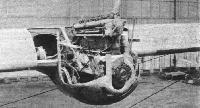
Варианты
- Zeppelin-Staaken - E.4/20 - 1920 - Германия
- Rohrbach - Ro.VIII Roland - 1926 - Германия
Zeppelin-Staaken. Семейство R
<...>
В послевоенное время построили еще один самолет-гигант - E.4/20, разработанный инженером Адольфом Рорбахом, радикально отличавшийся от своих предшественников. Это был транспортный высокоплан с четырьмя 245-сильными (183 кВт) ПД Maybach. Экипаж из двух человек размещался в открытой кабине, а в фюзеляже была организована кабина для 18 пассажиров. Прошедший испытания осенью 1920 года, самолет попал под ограничения Контрольной комиссии Союзников и был пущен на слом два года спустя.
Описание:
- Zeppelin-Staaken. Семейство R
- Flight, March 1921
THE ZEPPELIN-STAAKEN ALL-METAL MONOPLANE
Фотографии
-
История Авиации 2003-02 / С.Корж - Коммерческая авиация /Ретроспектива/ (7)
Глядя на совершенные формы E.4/20, даже не верится, что этот самолет был построен вскоре после окончания Первой Мировой войны. Будучи поистине "гостем из будущего", он, по понятным причинам, не вписался в реалии. А жаль...
Стойки, идущие от шасси, крепятся на амортизаторах и не разгружают крыло в полете. Поэтому схема самолета - не подкосный моноплан, как кажется на первый взгляд, а свободнонесущий высокоплан -
OS 1 / H.Cowin - X-Planes
The large aircraft was no longer a rarity by the end of World War I, thanks largely to the pioneering work of Sikorsky, Caproni, Handley Page and Farman. In this context, the often overlooked, short-lived Zeppelin Staaken E.4250. designed under the leadership of Adolf Rohrbach, deserves more than a fleeting mention. Starting life in 1918 as one of the new breed of German monoplane bombers, the four engined E.4250 was rapidly transformed into an airliner in the wake of the Armistice. Reported to have been briefly test flown towards the end of 1919, there were some indications that the machine was overweight for its total installed power. That may well have been the case, after all, such shortfalls were not that uncommon then, or, for that matter, for many years to come. What must be recognised is the visionary design approach of Rohrbach, who, taking the best of Hugo Junkers' and Claudius Dornier's innovations, came up with this magnificent design signpost to the classic high wing, monoplane airliner formula that was to be adopted by Fokker in Holland and by such Americans as 'Bill' Stout for his AT series and 'Jack' Northrop, for his Lockheed Vega design of 1928. Rohrbach's adoption of all-metal construction took longer to become universally accepted, with others following by the mid-1920s in the US; but it took about a decade longer in the case of all but a few of the more far-sighted European manufacturers.
-
Flight 1921-03 / Flight
THE ZEPPELIN-STAAKEN MONOPLANE: Three-quarter front view.
-
Flight 1920-11 / Flight
THE STAAKEN MONOPLANE: This machine, which is fitted with four Maybach engines of 260 h.p. each, was briefly described in our issue of October 28. Note the floral decorations
-
Aeroplane Monthly 1984-11 / J.Stroud - Wings of Peace
THE "ZEPPELIN STAAKEN": This machine was designed by Dr. Rohrbach and built in 1919. It was destroyed by order of the Inter-Allied Aeronautical Commission.
Adolf Rohrbach's very advanced E.4/20 which was built by Zeppelin-Werke at Staaken. -
Flight 1921-03 / Flight
THE ZEPPELIN-STAAKEN MONOPLANE: Three-quarter rear view.
-
Flight 1921-01 / Flight
The Zeppelin Staaken Monoplane in Flight: This machine, which is built of metal throughout, was described in a recent issue of FLIGHT. It carries 18 passengers in a comfortable cabin. Our photograph gives an excellent idea of the arrangement of the engines. The yawing moment set up by the cutting out of one of the outer engines must be very great, and this feature would appear to be a very bad one in an otherwise good design.
-
Flight 1921-03 / Flight
The Zeppelin-Staaken Monoplane: View of the engine nacelle with cowling and radiator removed. In this photograph may be seen the very deep front wing spar, and the opening through which the mechanic crawls into the engine housing.
-
Flight 1921-03 / Flight
The Zeppelin-Staaken Monoplane: View of the engine nacelle from behind.
-
Flight 1921-03 / Flight
A new Zeppelin-Staaken Monoplane: Our photograph, the first to be published in this country, shows the wind channel model of this new machine which is now being built at the Zeppelin works. This machine, it will be seen, will have two engines only, placed comparatively close together, so that the turning moment when one engine stops should be quite small.
- Фотографии









